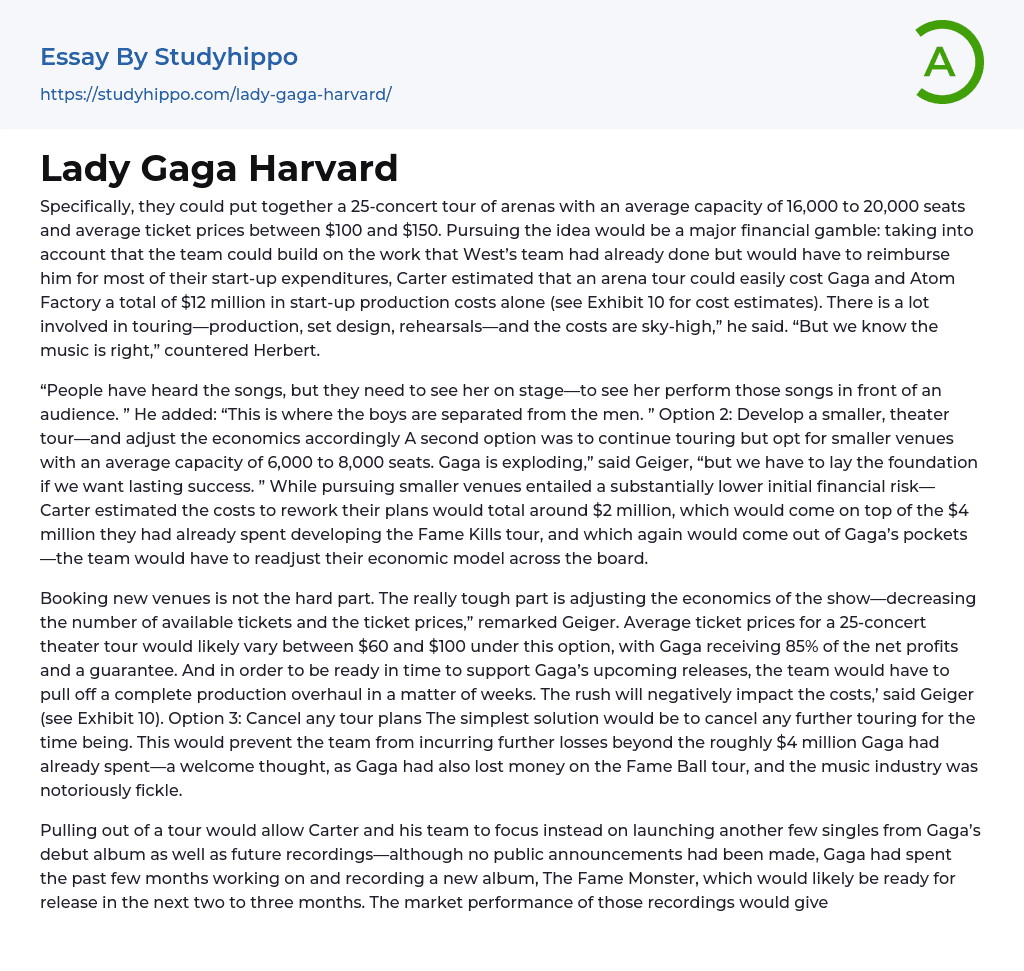Specifically, they could put together a 25-concert tour of arenas with an average capacity of 16,000 to 20,000 seats and average ticket prices between $100 and $150. Pursuing the idea would be a major financial gamble: taking into account that the team could build on the work that West’s team had already done but would have to reimburse him for most of their start-up expenditures, Carter estimated that an arena tour could easily cost Gaga and Atom Factory a total of $12 million in start-up production costs alone (see Exhibit 10 for cost estimates). There is a lot involved in touring—production, set design, rehearsals—and the costs are sky-high,” he said. “But we know the music is right,” countered Herbert.
“People have heard the songs, but they need to see her on stage—to se
...e her perform those songs in front of an audience. ” He added: “This is where the boys are separated from the men. ” Option 2: Develop a smaller, theater tour—and adjust the economics accordingly A second option was to continue touring but opt for smaller venues with an average capacity of 6,000 to 8,000 seats. Gaga is exploding,” said Geiger, “but we have to lay the foundation if we want lasting success. ” While pursuing smaller venues entailed a substantially lower initial financial risk—Carter estimated the costs to rework their plans would total around $2 million, which would come on top of the $4 million they had already spent developing the Fame Kills tour, and which again would come out of Gaga’s pockets—the team would have to readjust their economic model across the board.
Booking new venues is
not the hard part. The really tough part is adjusting the economics of the show—decreasing the number of available tickets and the ticket prices,” remarked Geiger. Average ticket prices for a 25-concert theater tour would likely vary between $60 and $100 under this option, with Gaga receiving 85% of the net profits and a guarantee. And in order to be ready in time to support Gaga’s upcoming releases, the team would have to pull off a complete production overhaul in a matter of weeks. The rush will negatively impact the costs,’ said Geiger (see Exhibit 10). Option 3: Cancel any tour plans The simplest solution would be to cancel any further touring for the time being. This would prevent the team from incurring further losses beyond the roughly $4 million Gaga had already spent—a welcome thought, as Gaga had also lost money on the Fame Ball tour, and the music industry was notoriously fickle.
Pulling out of a tour would allow Carter and his team to focus instead on launching another few singles from Gaga’s debut album as well as future recordings—although no public announcements had been made, Gaga had spent the past few months working on and recording a new album, The Fame Monster, which would likely be ready for release in the next two to three months. The market performance of those recordings would give team Gaga a clearer picture of what kind of tour they should pursue for Gaga in the future. Carter knew that he had only a few days to make the biggest decision of Gaga’s nascent career. What was the best option?
- Money essays
- Financial Accounting essays
- Market Segmentation essays
- Supply And Demand essays
- Purchasing essays
- Forecasting essays
- Legacy essays
- Bank essays
- Corporate Finance essays
- Financial News essays
- Financial Ratios essays
- Financial Services essays
- Free Market essays
- Shareholder essays
- Personal finance essays
- Equity essays
- Financial Crisis essays
- Banking essays
- Credit Card essays
- Currency essays
- Debt essays
- Gold essays
- Loan essays
- Enron Scandal essays
- Foreign Exchange Market essays
- Investment essays
- Venture Capital essays
- Stock Market essays
- Retirement essays
- Donation essays
- Net Present Value essays
- Income Statement essays
- Commercial Bank essays
- Debit Card essays
- Deposit Account essays
- Subprime Lending essays
- Perfect Competition essays
- Underwriting essays
- Synergy essays
- Valuation essays
- Investing essays
- Asset essays
- Depreciation essays
- Discounted Cash Flow essays
- Foreign Direct Investment essays
- Funds essays
- Internal Rate Of Return essays
- Revenue essays
- Day Trading essays
- Futures Trading essays




